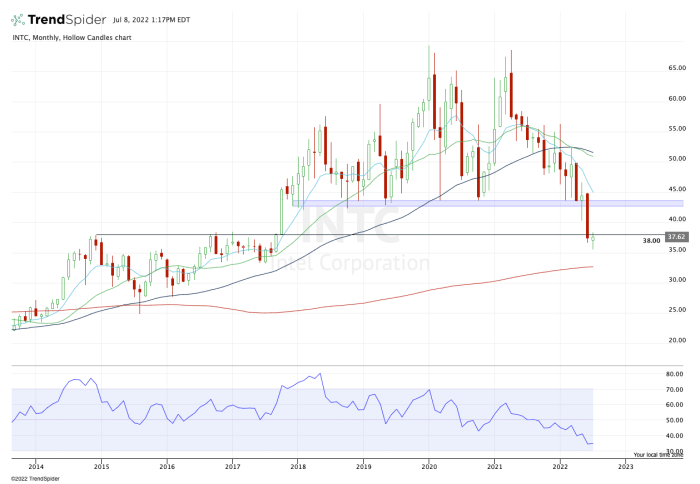Uncategorized
If Intel Stock Breaks Another Key Support Level — What Happens?

Intel (INTC) – Get Intel Corporation Report is far from its position as investors’ favorite semiconductor stock. It may pay a 3.9% dividend yield and trade at less than seven times last year’s earnings, but that doesn’t paint the full picture.
In the semiconductor world, we’ve seen a massive correction as investors fear a global recession. Some argue that we’re already there.
Regardless, that sentiment or reality directly affects semiconductor stocks, which are used in virtually every industry.
With the correction in semiconductor stocks, valuations at companies like Advanced Micro Devices (AMD) – Get Advanced Micro Devices Inc. Report, Nvidia (NVDA) – Get NVIDIA Corporation Report and Taiwan Semiconductor (TSM) – Get Taiwan Semiconductor Manufacturing Company Ltd. Report suddenly appear reasonable.
These companies may not pay a near-4% yield, but they are forecast to grow. Intel badly lags at the moment.
It may trade at 6.8 times last year’s earnings, but it trades at almost 11 times this year’s earnings. Why? Because profit is forecast to fall 36% at the Santa Clara, Calif., chip giant as revenue stays flat.
In other words, margins are narrowing. Just yesterday, Goldman Sachs said to buy puts ahead of earnings.
After holding a key level in the $40s in each month of the first quarter, Intel wavered on this zone in May and broke below it in June. Now it’s flirting with losing another level of support.
Scroll to Continue
What happens then?
Trading Intel Stock
The $42.50 to $44 zone was key for Intel stock. After a powerful breakout over $38 in the fourth quarter of 2017, this $42.50 to $44 zone has been strong support since the beginning of 2018.
It held during the fourth-quarter selloff in 2018, the covid-19 crash and countless times in between.
Not only did Intel stock finally drop through this level in June, it actually closed below a second key support level near $38 — the prior breakout level from Q4 2017.
Now it’s trying to recover this area and is struggling with $38.
If this level is reclaimed, then it opens the door back to $40, followed by the $42.50 to $44 area and the declining 10-month moving average.
On the downside, a move below the July low at $35.50 opens Intel stock up to more downside. Specifically, it could put the 200-month moving average in play near $32.50.
Uncategorized
BofA Securities maintains Amazon.com at ‘buy’ with a price target of $154.00
Uncategorized
Six people in critical condition, one still missing after Paris blast – prosecutor

5/5
© Reuters. French firefighters and rescue forces work after several buildings on fire following a gas explosion in the fifth arrondissement of Paris, France, June 21, 2023. REUTERS/Gonzalo Fuentes
2/5
PARIS (Reuters) – Six people remained in a critical condition and one person was believed still missing on Thursday, one day after a blast ripped through a street near Paris’ historic Latin Quarter, the city’s public prosecution office said. “These figures may still change,” prosecutor Maylis De Roeck told Reuters in a text message, adding that around 50 people had been injured in the blast, which set buildings ablaze and caused the front of one to collapse onto the street. Of two people initially believed missing, one has been found in hospital and is being taken care of, the prosecutor said, adding: “Searches are ongoing to find the second person.” Authorities have not yet said what caused the explosion, which witnesses said had followed a strong smell of gas at the site. The explosion led to scenes of chaos and destruction in the historic Rue Saint Jacques, which runs from the Notre-Dame de Paris Cathedral to the Sorbonne University, just as people were heading home from work. It also destroyed the facade of a building housing the Paris American Academy design school popular with foreign students. Florence Berthout, mayor of the Paris district where the blast occurred, said 12 students who should have been in the academy’s classrooms at the time had fortunately gone to visit an exhibition with their teacher.
“Otherwise the (death toll) could have been absolutely horrific,” Berthout told BFM TV. She said three children who had been passing by at the time were among the injured, although their lives were not in danger.
Uncategorized
4 big analyst cuts: Alcoa & DigitalOcean shares drop on downgrades

© Reuters.
Here is your Pro Recap of the biggest analyst cuts you may have missed since yesterday: downgrades at Alcoa, DigitalOcean, Teleflex, and Xcel Energy.InvestingPro subscribers got this news in rapid fire. Never be left in the dust again.Alcoa stock drops on Morgan Stanley downgrade Alcoa (NYSE:) shares fell more than 3% pre-market today after Morgan Stanley downgraded the company to Underweight from Equalweight and cut its price target to $33.00 from $43.00, as reported in real time on InvestingPro.The firm sees a significant decline in consensus estimates, and as negative earnings revisions materialize, it believes the stock will face downward pressure and underperform.The analyst’s estimates for EBITDA in Q2, 2023, and 2024 are substantially lower than the consensus. The stock is currently trading above its historical average. The firm said its downward revisions in earnings estimates and price target are attributed to the company’s high operating leverage to aluminum prices.DigitalOcean stock plunges on downgradePiper Sandler downgraded DigitalOcean (NYSE:) to Underweight from Neutral with a price target of $35.00. As a result, shares plunged more than 5% pre-market today.The company reported its last month, with revenue beating the consensus estimate, while EPS coming in worse than expected. Furthermore, the company provided a strong outlook, which was above the Street estimates.2 more downgradesTeleflex (NYSE:) shares fell more than 3% yesterday after Needham downgraded the company to Hold from Buy, noting that UroLift expectations may still be too high.According to Needham, their checks indicate that urologists are reducing their use of UroLift due to its retreatment rates, reimbursement cuts, and increasing use of competing procedures. This is also supported by their Google Trends data analysis, which indicates decreasing search interest in UroLift.BMO Capital downgraded Xcel Energy (NASDAQ:) to Market Perform from Outperform and cut its price target to $64.00 from $69.00 to reflect the lower-than-expected terms of the company’s regulatory settlement in Colorado.Amid whipsaw markets and a slew of critical headlines, seize on the right timing to protect your profits: Always be the first to know with InvestingPro.Start your free 7-day trial now.

 Forex2 years ago
Forex2 years agoForex Today: the dollar is gaining strength amid gloomy sentiment at the start of the Fed’s week

 Forex2 years ago
Forex2 years agoHow is the Australian dollar doing today?

 Forex2 years ago
Forex2 years agoUnbiased review of Pocket Option broker

 Forex2 years ago
Forex2 years agoDollar to pound sterling exchange rate today: Pound plummeted to its lowest since 1985

 Cryptocurrency2 years ago
Cryptocurrency2 years agoWhat happened in the crypto market – current events today

 World2 years ago
World2 years agoWhy are modern video games an art form?

 Stock Markets2 years ago
Stock Markets2 years agoMorgan Stanley: bear market rally to continue

 Economy2 years ago
Economy2 years agoCrude oil tankers double in price due to EU anti-Russian sanctions



































